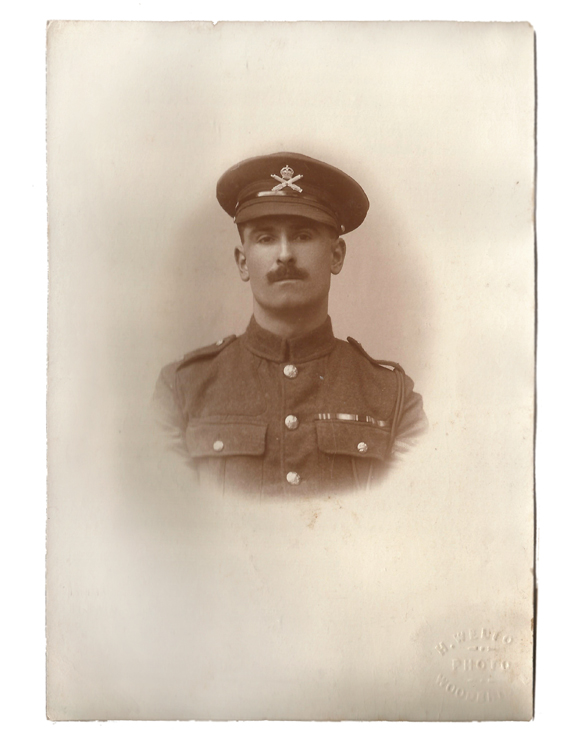Frederick James Beaden was born in Melton on 10th April 1896, the youngest son of James and Eliza. In 1911, Frederick was working in the family business a wheelwright, but on 17th January 1912, Frederick signed on as a “Boy 2nd Class” in the navy. He headed to the training school at HMS Ganges in Shotley, Suffolk, with the intention of fully enlisting on his 18th birthday. The records show that although he was of good character and satisfactory ability, his naval career ended after a month. His record shows that he was “discharged by purchase” by his father on the payment of £10.
When Frederick turned eighteen, he joined the Suffolk Regiment and became a member of the Special Reserve (signified by having a “3/” prefix to his service number). The intention would have been for Frederick to train with the regular army for three months before returning to civilian life to await a call to arms. However, due to his age and the declaration of war he was posted to 9th (Service) Battalion, Suffolk Regiment in Shoreham, Kent, for training. They spent their first three months under canvas in extremely wet conditions before being billeted in Brighton. In March 1915, the battalion returned to Shoreham to continue with their training before being deployed to France almost thirteen months after the war had begun.
Frederick and his colleagues embarked from Folkstone, arriving in Boulogne, on 31st August 1915. After a night in camp, they marched to the central station and boarded a train for Montreuil. Upon arrival, the battalion marched to billets in Alette, a village eight kilometres away, where they continued their training until 21st September when they received orders to leave. That afternoon, they set off on a three-day route march finishing in Bethune, a mining area in France, some seventy kilometres (forty-three miles) to the east. Almost as soon as they arrived in Bethune further orders were received sending them to the front line to a trench called “Quality Street” nearby to Bethune Fosse No.9 – a “fosse” was another term for a mine. On 26th September, the battalion’s orders were to take part in an advance to capture enemyheld territory. It was in this action, part of the Battle of Loos, that the first Victoria Cross won by a member of the 9th Suffolks was awarded to Serjeant Arthur F Saunders.
The months from October 1915 through to August the following year were a cycle of training periods followed by times in the trenches near to Poperinghe in Belgium. In early September 1916, the battalion went south to the Somme area and, on the 11th, they were in trenches near Combles. It was here, on 13th September, the battalion was ordered to advance and take the high ground between Morval and Les Boeufs. In front of them lay a heavilydefended German redoubt known as the Quadrilateral that had withstood several previous attempts at capture, causing significant casualties within the ranks of the attacking forces. The 9th Suffolks assaulted the Quadrilateral over the next two days with little success and were relieved during the evening of the 15th by the 14th Battalion Durham Light Infantry by whom the Quadrilateral was captured the next day.
The actions of the 9th Suffolks on 15th September 1916 were described in the battalion war diary:
“Battalion in Trenches. The Brigade were ordered to attack the enemy Trenches and to push on to their final objective which was between LES BOUCHS and MORVAL and establish a line on the ridge. The Brigade ordered the 1st Leicester’s and 9th Norfolks to attack at 6:20 am. The 2nd Sherwood’s and 9th Suffolks were in support, the 9th Suffolks supporting the 9th Norfolks. The battalion lined up to move forward at 7:50 am but owing to very heavy artillery and machine gun fire half of “C” Company could not leave the trench. The remainder of the battalion moved forward but were held up by heavy machine-gun fire which came from the strong enemy position called the QUADRILATERAL. It was from the machine guns that the battalion lost very heavily. Lieut. Col. A P MACK was killed at 8.30am. The remainder of the battalion dug themselves in and got in touch with both flanks. The enemy barrage was extremely heavy and caused many more casualties. The battalion held the line they established till relieved by the 14th Durham Light Infantry at 11pm and moved back to support trenches where they re-organised.”
It was probably during this action that Frederick was awarded the Military Medal to match his brother William’s, won only a few weeks before. Frederick was transferred to the Machine Gun Corps towards the end of his time in the army, possibly in February 1918, when the 9th Battalion, Suffolk Regiment, was disbanded. It is also likely that he became a member of the army of occupation once the war was over as he was not demobilised until 3rd March 1920.
In 1930, Fred married Florence Clarke (née Wood) in Woodbridge. Florence had lost her first husband, Arthur James Clarke, to the Spanish Flu epidemic while serving in France. From there, the couple moved to Ruislip in London where Fred worked as an attendant in a public institution, suggesting he may have worked some time at St Audry’s Hospital once the war was over. Fred died in 1967 and his wife, Florence, eleven years later in 1978. Both are buried in Woodbridge Cemetery. They had no children.
In addition to his Military Medal, Fred received the 1914-15 Star and the British War and Victory Medals.

